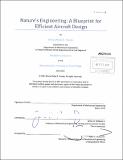Nature's engineering : a blueprint for efficient aircraft design
Author(s)
Pineda, Elvine Philip B., II
DownloadFull printable version (8.736Mb)
Alternative title
Blueprint for efficient aircraft design
Other Contributors
Massachusetts Institute of Technology. Dept. of Mechanical Engineering.
Advisor
James H. Williams Jr.
Terms of use
Metadata
Show full item recordAbstract
The flight of birds inspired engineers like Leonard da Vinci and Wilbur and Orville Wright to design aircraft that mimic the behavior they observed. The success of the Wright brothers' first controllable aircraft ushered in an era of rapid advances in aviation technology leading to the airplanes of today. Despite these advances, airplanes possess many restrictions that prevent them from being as efficient as their nature-engineered counterparts. Researchers have thus returned to the methods of the earlier engineers in aviation and begun observing birds to look for ways to improve aircraft design. Two methods currently being researched to improve aircraft efficiency are morphing wings and perching. Morphing wings allow airplanes to change the shape of their wings to suit the needs of their mission. Perching is a landing maneuver that uses the nonlinear dynamics of stall to create the drag forces necessary to decelerate the aircraft. Experiments on these methods prove them viable for implementation in small scale aircraft such as remote-controlled planes and unmanned aerial vehicles. However, because of the complexities involved in both morphing wings and perching, further developments are necessary to achieve full implementation.
Description
Thesis (S.B.)--Massachusetts Institute of Technology, Dept. of Mechanical Engineering, 2011. Cataloged from PDF version of thesis. Includes bibliographical references (p. 34).
Date issued
2011Department
Massachusetts Institute of Technology. Department of Mechanical EngineeringPublisher
Massachusetts Institute of Technology
Keywords
Mechanical Engineering.